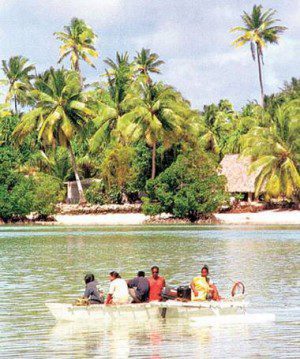
There was much in the way of climate change and global warming news released this past week. While a lot of it, as is typical, was politically, emotionally and otherwise rhetorically slanted, there also was much of substance in terms of efforts to better understand what’s happening globally and locally in terms of climate change, as well efforts to do with climate change mitigation and adaptation.
- Perhaps most alarmingly portentous of the impact of climate change for human societies and civilization was news that the government of the South Pacific island of Kiribati are considering a range of relocation options, including relocating the entire population to man-made islands built along the lines of giant oil rigs, according to a report from the UK’s The Independent. Another option: relocating the populace to Fiji. Spanning some 33 coral atolls dotted across 2 million square miles of the Pacific, Kiribati’s highest point is a mere two meters above sea level. The island nation is losing land and crops to rising sea levels and seeing its freshwater sources contaminated by salt water. Attending the Pacific Islands Forum in Auckland, New Zealand last week, President Anote Tong last week told the Associated Press (AP) that his cabinet this week endorsed a plan to buy some 3,000 hectares on Vita Levu, Fiji’s main island with as a climate change insurance policy, should the nation’s 103,000 residents be forced to relocate. The government is also considering building massive sea walls, as well as super-sized, man-made derricks, but these would cost billions of dollars. Those dollars, largely, would have to come from international lending and aid agencies.
- Examining the issue of water supplies, food security and climate change from a global perspective, “an unprecedented rise in the demand for food, rapid urbanization and climate change are significantly threatening global water supplies,” according to the UN World Water Development Report, which is being released at the sixth UN World Water Forum in Marseille. Demand for food will increase 70% by 2050, prompting a 19% increase in demand for water by agriculture, which already consumes 70% of fresh water supplies, according to the report, entitled, “Managing Water Under Uncertainty and Risk. “The impact of climate change on water supplies will also increase, as a changing climate “will alter rainfall patterns and soil humidity, melt glaciers and cause water-related disasters such as floods and droughts, which impact food production.” These will affect as many as 44 million people around the world, the report authors estimate.
- Examining the issue of mass migrations caused by climate and environmental changes, the Asian Development Bank (ADB) is warning governments that they need to prepare for mass migrations due to rising sea levels, soil and fresh water degradation and seasonal droughts and flooding. Natural disasters, such as 2011’s floods in Thailand, forced 42 million people to relocate in the Asia-Pacific region in 2010, though exactly how much of this was caused by climate change remains uncertain. The Asia-Pacific is home to six of the ten countries considered most vulnerable to climate change. Fully 1/3 of Southeast Asia’s population lives in areas “at-risk,” including residents of Indonesia, Myanmar, the Philippines, Thailand and Vietnam, according to the report.
- Increasingly aware of the threats posed by climate change, Mexico’s government is moving forward with climate change legislation. Mexican states including the Federal District of Mexico City, Tabasco and Veracruz have individually enacted climate change bills. With nearly all of the country’s political parties in agreement, a national “unified General Climate Change Bill” is now progressing in the Mexican Senate. Aiming to consolidate and better organize Mexico’s climate change strategy and action plans, the draft bill would establish:
- a national system for addressing climate change;
- a national climate change policy, based on defined principles; and
- an independent authority, to be known as the National Institute of Ecology and Climate Change, which will be directed by a government committee created by certain federal ministries.
Image credit: the Independent
Related articles
- ADB: Climate change could spawn mass migrations (seattletimes.nwsource.com)
- Tornadoes & Climate Change in 2012 (planetsave.com)
- Climate Change and Tree Migration (globalwarmingisreal.com)
- Climate change threaten global water supplies: UN (newkerala.com)
- Climate Change – A Security Risk (chimalaya.org)
- Island President Rejects Climate Change Evacuation Stories (junkscience.com)
- Asia-Pacific Called Grossly Unprepared for Climate Change (blogs.voanews.com)
- Forests And Climate Change Adaptation In Asia (chimalaya.org)




Hello and thank you for this article.
So-called environmentally induced migration is multi-level problem. According to Essam El-Hinnawi definition form 1985 environmental refugees as those people who have been forced to leave their traditional habitat, temporarily or permanently, because of a marked environmental disruption (natural or triggered by people) that jeopardised their existence and/or seriously affected the quality of their life. The fundamental distinction between `environmental migrants` and `environmental refugees` is a standpoint of contemporsry studies in EDPs.
According to Bogumil Terminski it seems reasonable to distinguish the general category of environmental migrants from the more specific (subordinate to it) category of environmental refugees.
Environmental migrants, therefore, are persons making a short-lived, cyclical, or longerterm change of residence, of a voluntary or forced character, due to specific environmental factors. Environmental refugees form a specific type of environmental migrant.
Environmental refugees, therefore, are persons compelled to spontaneous, short-lived, cyclical, or longer-term changes of residence due to sudden or gradually worsening changes in environmental factors important to their living, which may be of either a short-term or an irreversible character.
According to Norman Myers environmental refugees are “people who can no longer gain a secure livelihood in their homelands because of drought, soil erosion, desertification, deforestation and other environmental problems, together with associated problems of population pressures and profound poverty”.